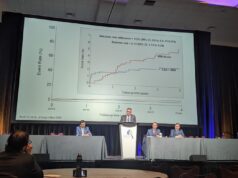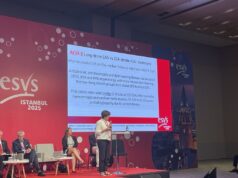
The results of an analysis of nearly 2,000 carotid endarterectomies (CEAs) “challenge the notion” that patients benefit significantly from the current postoperative surveillance guidelines, and suggest that these may be contributing to “oversurveillance”—an issue that should be addressed in future protocols for patient management post-CEA.
These were among the talking points to emerge from a presentation delivered by Colleen Flanagan (University of California San Francisco, San Francisco, USA), who presented the results of a retrospective study looking at the long-term results of post-CEA surveillance within an integrated regional healthcare system, delivered during a plenary session at the 2022 Vascular Annual Meeting (VAM; 15–18 June, Boston, USA).
Flanagan and colleagues, along with senior author Robert Chang, assistant chair of vascular surgery at Kaiser Permanente Foundation Hospital (San Francisco, USA), the healthcare system in question—sought to evaluate the long-term utility of surveillance after CEA in preventing stroke and identifying restenosis.
Current Society for Vascular Surgery (SVS) guidelines recommend a surveillance regimen consisting of up to five duplex ultrasound assessments in the first two years after a CEA, with annual scans thereafter, Flanagan noted in her presentation.
Conversely, current recommendations from the European Society for Vascular Surgery (ESVS) favour a less rigorous approach, advocating carotid artery surveillance if there are signs of cerebral malperfusion during carotid clamping.
The study included patients who underwent CEA for severe (70–99%) carotid artery stenosis between 2008 and 2012, who were then followed up until 2019. Flanagan described Kaiser Permanente as a “large, integrated regional healthcare system,” and detailed that patients who had undergone ipsilateral intervention previously, or who died within 30 days of their operation were excluded.
The primary outcomes, Flanagan told delegates, were ipsilateral severe restenosis or occlusion, and ipsilateral stroke. She also noted that a competing risks analysis was used to quantify freedom from the primary outcomes. In terms of results, 1,923 carotid arteries in 1,816 patients were treated with CEA during the study period, Flanagan noted, of which 831 (43.2%) were for symptomatic indication.
Mean follow-up time was 6.6 years (standard deviation=3.3 years). A median of three surveillance studies were completed across the patient population during the study period, lower than the five recommended under current SVS protocols, and 13.5% of patients received no postoperative surveillance at all, Flanagan reported.
The presenter noted that 1.4% of arteries underwent reintervention during the study period, and of the 71 ipsilateral postoperative strokes that occurred, only three occurred in the setting of a known severe restenosis. The five-year risk of severe restenosis, occlusion and ipsilateral stroke seen in the study were 6%, 9.9% and 2.7% respectively, Flanagan noted.
“The risk of severe restenosis and occlusion were especially low, if [a] patient’s first postoperative imaging study was normal, whereas ipsilateral stroke decreased only slightly,” she stated.
“Despite less frequent surveillance compared to SVS guidelines, our observed ipsilateral stroke rate was actually lower than those previously reported in clinical trials,” Flanagan went on to remark. “Risk of restenosis was also particularly low, especially if the patients received a normal postoperative imaging study.
“Our data suggest a reconsideration of carotid surveillance protocols are warranted after CEA. Following a normal first postoperative imaging study, additional scans are likely not necessary.”
The study team is conducting further analysis in order to identify any sub-populations that may require more frequent surveillance and attempting to understand the concurrent contralateral disease rate within this population, the presenter reported. The study’s findings elicited a strong response from SVS president Ali AbuRahma (West Virginia University, Morgantown, USA), speaking from the floor, who commented that he has been “preaching on the same issue” for over a decade.
AbuRahma said he had been involved in collecting randomised trial data over 10 years ago, which he said suggest that: “If you do surgery right from the first time…the value of having postoperative ultrasound frequently, to me, was absolutely unacceptable.”
A need for additional and unnecessary surveillance may place an increased financial burden on overstretched healthcare systems, he said. “I am trying to keep that in mind when we put the guidelines together this time for carotid management,” AbuRahma commented further. “I want the audience to be careful and perhaps we need to revisit the same issue.”
Expanding, Flanagan told Vascular Specialist@VAM that “oversurveillance is a problem, primarily because it constrains important resources that other patients need”. The day-to-day implications of this overuse of finite hospital resources can be delays in access imaging, which many patients require as part of screening, surveillance or diagnosis of their conditions, the research team elaborated.









